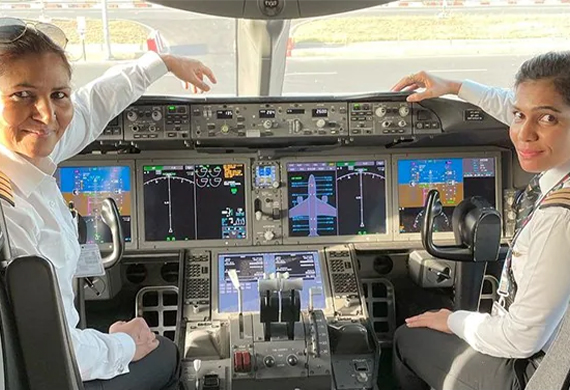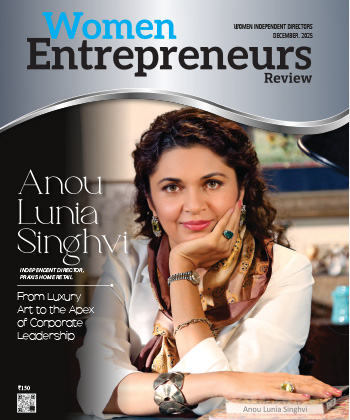
Female Pilots no Longer a Rarity in India with double the number as Compared to the U.S.
By: WE Staff | Friday, 12 August 2022
India has more female airline pilots than any other country in the world. Here is a look at the various factors that helped India achieve the highest percentage (12.4 percent) in terms of female pilot.
The debut of Akasa Air and Jet Airways' second phase have created a stir in the Indian aviation sector. Additionally, with the reopening of international borders following the coronavirus, the quantity of domestic and international flights has returned to pre-pandemic levels. With all of activity going on, the demand for pilots in India has reached an all-time high.
Surprisingly, India has more female airline pilots than any other country in the world. Union Civil Aviation Minister Jyotiraditya Scindia stated in a February 2022 speech in the LokSabha that women make up 15 percent of the nation's pilot population. India is a success in terms of airline sector diversity because female pilots are no longer a novelty.
According to the International Society of Women Airline Pilots, India has the highest percentage of female pilots in the world at about 12.4% of all pilots, compared to 5.5% in the US, the world's largest aviation market, and 4.7% in the UK.
Nivedita Bhasin, an Indian pilot, recalls those formative years when other crew members would nudge her into the cockpit so that passengers wouldn't feel uncomfortable seeing a woman flying their aircraft. NiveditaBhasin became the youngest commercial airline captain in the world in 1989. But, now, Indian female pilots are no longer a novelty three decades after Bhasin's career began, making the nation a success story in terms of diversity in the airline business. In fact, first commercial female pilot in India was Durba Banerjee. Growing up, Banerjee enjoyed flying and was passionate about becoming a pilot. She was the first woman of her era to defy expectations and enter this industry. With 9000 hours, she holds the record for the most flying time.
The figures make one wonder how a country that ranked 135th out of 146 in the world for gender parity was able to buck the trend in this particular industry. Other nations and industries who aim to increase the representation of women may utilise some of the solutions as models. In general, diverse organisations operate more effectively, and some studies have even asserted that female pilots experience less safety-related problems. Additionally, after the world has recovered from the Covid outbreak and demand rises, employing more women could help airlines tackle the labour shortages that are resulting in travel delays.
Pioneers like Bhasin assert that Indian women are motivated for a variety of reasons, including outreach programmes, improved corporate practises, and strong family support. Many Indian women were drawn to aviation by the National Cadet Corps' air wing, which was established in 1948 and trains students to fly microlight aircraft. In order to make the expensive commercial pilot training more accessible to women, some state governments offer financial assistance, while companies like Honda Motor Co. provide full scholarships for an 18-month programme at an Indian flying school and support their employment.
"India has started decades ago recruiting women into STEM positions, including pilots," Bloomberg quoted Michele Halleran, a professor and director of diversity initiatives at Embry-Riddle Aeronautical University in Florida, as saying. “In the U.S., we have only started the demand for a diversity movement in aviation because of our current drastic pilot and technician shortage."
In the 1990s, the Indian Air Force started hiring female pilots for its transport and helicopter fleet. They weren't permitted to take on fighter responsibilities until this year.
Airlines' policies to retain Women Employees
In India, certain airlines are creating strategies to keep women in leadership positions. The biggest passenger airline in India, IndiGo, claimed to give female crew and pilots freedom to continue working safely, without flying tasks, while expecting. It provides the legally needed 26 weeks of paid maternity leave in addition to childcare facilities. Women pilots have the option of a flexible contract with two weeks of leave every month up until the age of five.
According to a spokesperson, Vistara gives pregnant pilots and cabin crew the choice of temporary jobs on the ground or administrative positions until they are ready to fly. Additionally, it offers a six-month paid maternity leave and covers creche costs.
Hana Khan, a commercial pilot with an Indian airline, said that some carriers also deploy a driver and security to drop off and pick up women travelling late at night.
Prosaic Rationale for Success
Another more mundane justification for the success of many Indian women pilots is family support. In a profession that necessitates long hours and frequent travel away from home, the familial structure in India, where extended families frequently live together and grandparents and aunts frequently help raise children or manage households, is especially beneficial.
Advantages of Employing Female Talent
The absolute numbers of women pilots still tend to be higher in the US than in India because airline markets in countries like the US are significantly larger and have a larger overall staff that includes both men and women.
By employing more women, the ongoing pilot and airport staff deficit that is forcing airlines to reduce and cancel flights and jeopardising the aggressive traffic recovery can be resolved. According to Boeing Co., the world will need more than 600,000 additional pilots over the next 20 years.
Many believe the benefits may extend even farther and may be the reason why India's aviation safety rating are greater than those of certain developed nations.
The US has had roughly five times as many fatal air disasters as India since 1945, while the UK has witnessed 15 more disastrous occurrences, according to the Aviation Safety Network.
Gender Disparities in Accidents
According to the Aviation Safety Network, the US has seen nearly five times as many fatal air crashes as India since 1945, while the UK has experienced 15 more tragic events.
The fact that the US has a larger aviation industry than India may account for certain statistical discrepancies because more flights increase the likelihood of accidents. However, many pilots feel that having a sizable female population is at the very least beneficial to safety.
According to a research titled Gender Differences In General Aviation Crashes, which examined data on helicopter and aeroplane crashes between 1983 and 1997, male pilot crash rates were higher than those of female pilots. Women in Combat Arms: A Study of the Global War on Terror examined the accident rates of male and female pilots from 2002 to 2013, finding that women "fly aircraft more safely," accounting for only 3% of accidents despite making up 10% of all US army helicopter pilots.
According to Halleran, a professor at Embry-Riddle Aeronautical University, increasing diversity has the potential to make air travel safer because women frequently take a more calculated attitude to risk and are consequently involved in fewer accidents than men.
Women's Dedication in the Aviation Sector
At the Indian flight school Indira Gandhi RashtriyaUranAkademi, chief flight instructor Kunjal Bhatt noted that she found female trainees to be particularly "meticulous" and displaying greater dedication to succeed because the stakes are higher for those who defy social norms to pursue this profession.
Indian women who have made it in the aviation industry are teaching young females about the sector. Harpreet A. De Singh runs outreach initiatives in schools to increase awareness of careers such as pilots, technicians, and air traffic controllers. She became the first woman to lead an Indian airline when she assumed leadership of Alliance Air Aviation Ltd. in 2020.
“Over a period of time this consistent effort all over the country has led to large number of women choosing a profession some didn’t even know it existed,” Singh said.
Most Viewed
- 1 Women's Health Startup HerMD Closing Doors Amid Industry Challenges
- 2 5 Famous Women in Indian Armed Forces
- 3 Saudi Women No longer Require Male Permission for Clothing Choices, says Prince MbS
- 4 Kolkata Medtech Startup Innovodigm Raises Rs 5.5 Crore Seed Funding Led by IAN Group
- 5 Yamunanagar's Kashish Kalra Honoured after Securing 111th Rank in UPSC Civil Services Exam
- 6 Madurai Appoints Its First Woman Corporation Head
- 7 IAS Vijayalakshmi Bidari Appointed as the new Nagpur Divisional Commissioner
- 8 American Entrepreneur Lucy Guo Overtakes T Swift to become Youngest Female Billionaire
- 9 ICC Women's World Cup 2025 Trophy Showcased at Indore's Holkar Stadium
- 10 Aparna Saxena's Beauty Venture AntiNorm Launches in India
- 11 Vidya Nataraj Co-Founded BlueStone Jewellery & Lifestyle files IPO
- 12 5 Women Freedom Fighters of India
- 13 Dr. G Krishnapriya appointed as CEO for Trichy
- 14 M3M & Sirona Partner to Introduce Menstrual Hygiene Vending Machines in 15 Locations
- 15 Punjab Govt launches SHE Cohort 3.0 Supporting Tech-led Women Startups
- 16 Indian origin Lawyer, Sweena Pannu appointed as the US New Superior Court Judge
- 17 The Aurora Tech Award recognizes 4 Indian Women-led Startups
- 18 Kerala's Republic Day parade featured an all-female tableau
- 19 Manisha Kabbur Becomes Karnataka's First Woman International Karate Coach
- 20 Director K. S. Ravikumar's Daughter Maalica Ravikumar Launches Life Coaching Company 'Evergrowth Academy' for Women
- 21 Leezu's Raises Pre-Seed Funding to Accelerate Growth in Sexual Wellness Industry
- 22 Sattu: Super-easy summer drink for PCOS gut healing
- 23 Swathi Nelabhatla creates Sitha App, India's First Women-Exclusive Gig Platform
- 24 7 Timeless Female Kathak Dancers & their Iconic Legacies
- 25 Meet 7 Iconic Women Architects of Modern India & their Most Impactful Work
- 26 This Woman-led Insuretech Startup is Helping Bridge the Education Financing Gap in India
- 27 Women Leaders Share Lessons Learnt from India Women's WC Win
- 28 5 Enterprising Women Founders Powering Singapore's Tech & Innovation Landscape
- 29 4 Women. 4 Stories. One Vision for Smarter, Stronger Healthcare
- 30 Global Gender Gap Narrows to 68.8%, But Full Equality 123 Years Away: WEF Report 2025
- 31 Changemakers: 7 Women Entrepreneurs Taking the Make in India Movement Forward
- 32 Meet Lucy Guo, The Youngest Self-Made Female Billionaire Disrupting Tech
- 33 How Women are Driving India's Festive Online Shopping Surge






